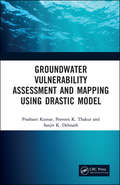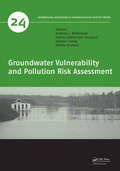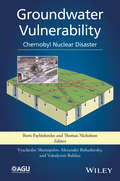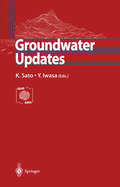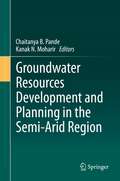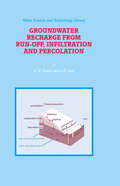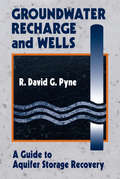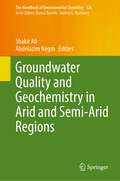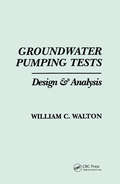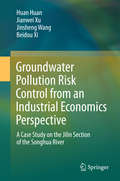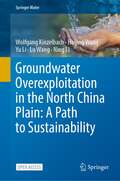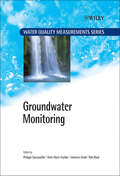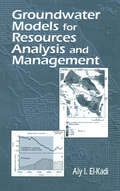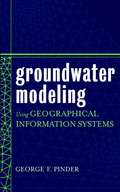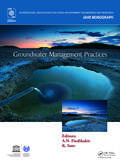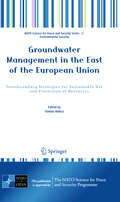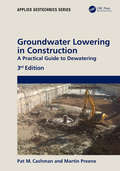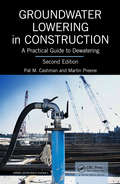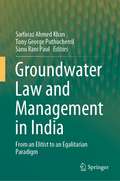- Table View
- List View
Groundwater Vulnerability Assessment and Mapping using DRASTIC Model
by Prashant Kumar Praveen Thakur Sanjit DebnathThis book shows the effectiveness of DRASTIC model in a geographical setting for validation of vulnerable zones and presents the optimization of parameters for the development of precise maps highlighting several zones with varied contamination. Impact of vadose zone has also been assessed by considering every sub-surface layer. Exclusive title covering effectiveness of DRASTIC model for groundwater vulnerability assessment Reviews of the strengths and limitations of assessment methods Presents multi-criteria evaluation of hydro-geological and anthropogenic factors Discusses integration with geographic information system (GIS) and remote sensing (RS) Includes application of groundwater governance framework with a case study study of a geographical setting
Groundwater Vulnerability and Pollution Risk Assessment (IAH - Selected Papers on Hydrogeology #24)
by Andrzej J. Witkowski Sabina Jakóbczyk-Karpierz Joanna Czekaj Dorota GrabalaThis volume offers detailed comparisons and validations of different methods of assessing groundwater vulnerability (DRASTIC, GOD, PI, RTt, AVI, SINTACS, COP). It contains new aspects of vulnerability assessment for the evaluation of coastal aquifer vulnerability and aquifer vulnerability to methane gas leakage from shale gas wells. The book also contains the results of studies on intrinsic and specific vulnerability assessment (migration of antibiotics and nitrate, groundwatersurface water interaction), with examples of the different national approaches to groundwater vulnerability mapping in Poland, Ireland, Italy and elsewhere. There are 15 chapters derived from two IAH conferences held in Ustron´, Poland in 2015 and 2018. The book is valuable for those interested in groundwater vulnerability, in risk assessment, and in environmental issues. It is aimed at land use planners, water managers, the environmental industry, regional and local environmental protection councils and students studying hydrogeology and environmental sciences.
Groundwater Vulnerability and Pollution Risk Assessment (IAH - Selected Papers on Hydrogeology #24)
by Andrzej J. Witkowski Sabina Jakóbczyk-Karpierz Joanna Czekaj Dorota GrabalaThis volume offers detailed comparisons and validations of different methods of assessing groundwater vulnerability (DRASTIC, GOD, PI, RTt, AVI, SINTACS, COP). It contains new aspects of vulnerability assessment for the evaluation of coastal aquifer vulnerability and aquifer vulnerability to methane gas leakage from shale gas wells. The book also contains the results of studies on intrinsic and specific vulnerability assessment (migration of antibiotics and nitrate, groundwatersurface water interaction), with examples of the different national approaches to groundwater vulnerability mapping in Poland, Ireland, Italy and elsewhere. There are 15 chapters derived from two IAH conferences held in Ustron´, Poland in 2015 and 2018. The book is valuable for those interested in groundwater vulnerability, in risk assessment, and in environmental issues. It is aimed at land use planners, water managers, the environmental industry, regional and local environmental protection councils and students studying hydrogeology and environmental sciences.
Groundwater Vulnerability: Chernobyl Nuclear Disaster (Special Publications #207)
by Vyacheslav Shestopalov Alexander Bohuslavsky Volodymir BubliasThe Chernobyl Nuclear Power Plant (NPP) disaster that occurred in Ukraine on April 26, 1986, was one of the most devastating in human history. Using this as a case study, the AGU monograph Groundwater Vulnerability: Chernobyl Nuclear Disaster is devoted to the problem of groundwater vulnerability, where the results of long-term field and modeling investigations of radionuclide transport in soil and groundwater, within the Ukrainian part of the Dnieper River basin (Kyiv region of Ukraine), are discussed. The authors provide a comprehensive review of existing literature on the assessment of groundwater vulnerability and then describe an improved methodology, which is developed based on integration of the methods of hydrogeological zonation and modeling of anomalously fast migration of radioactive contaminants from the land surface toward groundwater. This volume also includes the evaluation of the effect of preferential and episodic flow on transport of radionuclides toward the aquifers and risk assessment of groundwater vulnerability, which can further assist future researchers in developing remediation technologies for improving drinking water quality. Further, this volume sheds light on the consequences of groundwater contamination from nuclear disasters and assists with assessing the risks associated with contamination and developing effective remediation technologies. Volume highlights include discussions of the following: Assessment of groundwater vulnerability to contamination from the Chernobyl nuclear disaster Novel analytical results of the 25-year investigations of groundwater contamination caused by Chernobyl-born radionuclides The wealth of data on different modes of radioactive transport in the atmosphere, water, and soils, and along the food chains The hydrogeological and physico-chemical processes and factors in groundwater contaminated zones The applicability of commonly used methods of the evaluation of groundwater vulnerability A unique method of fluid dynamics that involves an anomalously fast migration of contaminants through zones of preferential flow from the land surface toward groundwater Building confidence in the assessment of migration pathways of radionuclides in the biosphere Assessment and prediction of the consequences of the nuclear accident, which can shed light on protection from global nuclear accidents Analogue information for different nuclear waste disposal and environmental projects around the world
Groundwater Vulnerability: Chernobyl Nuclear Disaster (Special Publications #207)
by Vyacheslav Shestopalov Alexander Bohuslavsky Volodymir BubliasThe Chernobyl Nuclear Power Plant (NPP) disaster that occurred in Ukraine on April 26, 1986, was one of the most devastating in human history. Using this as a case study, the AGU monograph Groundwater Vulnerability: Chernobyl Nuclear Disaster is devoted to the problem of groundwater vulnerability, where the results of long-term field and modeling investigations of radionuclide transport in soil and groundwater, within the Ukrainian part of the Dnieper River basin (Kyiv region of Ukraine), are discussed. The authors provide a comprehensive review of existing literature on the assessment of groundwater vulnerability and then describe an improved methodology, which is developed based on integration of the methods of hydrogeological zonation and modeling of anomalously fast migration of radioactive contaminants from the land surface toward groundwater. This volume also includes the evaluation of the effect of preferential and episodic flow on transport of radionuclides toward the aquifers and risk assessment of groundwater vulnerability, which can further assist future researchers in developing remediation technologies for improving drinking water quality. Further, this volume sheds light on the consequences of groundwater contamination from nuclear disasters and assists with assessing the risks associated with contamination and developing effective remediation technologies. Volume highlights include discussions of the following: Assessment of groundwater vulnerability to contamination from the Chernobyl nuclear disaster Novel analytical results of the 25-year investigations of groundwater contamination caused by Chernobyl-born radionuclides The wealth of data on different modes of radioactive transport in the atmosphere, water, and soils, and along the food chains The hydrogeological and physico-chemical processes and factors in groundwater contaminated zones The applicability of commonly used methods of the evaluation of groundwater vulnerability A unique method of fluid dynamics that involves an anomalously fast migration of contaminants through zones of preferential flow from the land surface toward groundwater Building confidence in the assessment of migration pathways of radionuclides in the biosphere Assessment and prediction of the consequences of the nuclear accident, which can shed light on protection from global nuclear accidents Analogue information for different nuclear waste disposal and environmental projects around the world
Groundwater Updates
by K. Sato Y. IwasaGroundwater is essential to life and to maintaining Earth's water cycle. In the face of growing threats to this invaluable resource, recent advances in research and analysis - notably in numerical simulation and data processing with computers - are bringing rapid changes in dynamic methodology for groundwater management and modeling. This book contains the latest updates from the field of groundwater science and engineering, organized around five major topics: Optimization of groundwater resources in basins, Groundwater pollution and remediation technologies, Underground development and groundwater technologies, Interaction between surface and subsurface water, and Reliability of numerical methods and scaling in geohydraulics. This collection of more than 80 papers by leading specialists provides a valuable source of information for researchers, engineers, and students in the field of groundwater resources and management.
Groundwater Resources Development and Planning in the Semi-Arid Region
by Chaitanya B. Pande Kanak N. MoharirThis book addresses the various challenges in achieving sustainable groundwater development, management, and planning in semi-arid regions, with a focus on India, and discusses advanced remote sensing and GIS techniques for the estimation and management of groundwater resources. The book is timely as there is a need for a better understanding of the various tools and methods required to efficiently and sustainably meet the growing demand for clean surface and groundwater in developing countries, and how these tools can be combined with other strategies in a multi-disciplinary fashion to achieve this goal in water-scarce regions. To wit, the book combines remote sensing and GIS techniques, runoff modeling, aquifer mapping, land use and land cover analyses, evapotranspiration estimation, crop coefficients, and water policy approaches. This will be of use to academics, policymakers, social scientists, and professionals involved in the various aspects of sustainable groundwater development, planning, and management.
Groundwater Recharge from Run-off, Infiltration and Percolation (Water Science and Technology Library #55)
by K.-P. Seiler J.R. GatTo face the threats to the water supply and to maintain sustainable water management policies, detailed knowledge is needed on the surface-to-subsurface transformation link in the water cycle. Recharge flux is covered in this book as well as many other groundwater issues, including a comparison of the traditional and modern approaches to determine groundwater recharge. The authors also explain in detail the fate of groundwater recharge in the subsurface by hydraulic and geologic means, in order to stimulate adapted groundwater-management strategies.
Groundwater Recharge and Wells: A Guide to Aquifer Storage Recovery
by R. David PyneUnderstanding the issues that have been encountered at other sites, and the steps that have led to successful resolution of these issues, can provide great help to those considering, planning, or implementing new groundwater recharge projects. Recent technical advances and operational experience have demonstrated that well recharge is a feasible and cost effective method of artificially recharging natural aquifers. This practical guide reviews the technical constraints and issues that have been addressed and resolved through research and experience at many sites. The book presents aquifer storage recovery (ASR) technology and traces its evolution over the past 25 years in the United States. Procedures for groundwater recharge are presented, and selected case studies are examined. Drinking water quality standards and conversion factors are provided in the appendix for easy reference.
Groundwater Recharge and Wells: A Guide to Aquifer Storage Recovery
by R. David PyneUnderstanding the issues that have been encountered at other sites, and the steps that have led to successful resolution of these issues, can provide great help to those considering, planning, or implementing new groundwater recharge projects. Recent technical advances and operational experience have demonstrated that well recharge is a feasible and cost effective method of artificially recharging natural aquifers. This practical guide reviews the technical constraints and issues that have been addressed and resolved through research and experience at many sites. The book presents aquifer storage recovery (ASR) technology and traces its evolution over the past 25 years in the United States. Procedures for groundwater recharge are presented, and selected case studies are examined. Drinking water quality standards and conversion factors are provided in the appendix for easy reference.
Groundwater Quality and Geochemistry in Arid and Semi-Arid Regions (The Handbook of Environmental Chemistry #126)
by Shakir Ali Abdelazim NegmThis book reviews groundwater quality and its major global contaminants, and collects the latest advances in the analysis, remediation, risk assessment, and hydrogeochemistry of groundwater in countries such as Algeria, Egypt, Ghana, Kazakhstan, Morocco, Saudi Arabia, and the USA. This book mainly focuses on the major arid and semi-arid areas where groundwater is scarce and highly polluted with geogenic and anthropogenic contaminants and the recharge to the groundwater is negligible due to limited rainfall. Divided into 2 parts, the book starts by covering topics like assessment and protection of groundwater in arid and semi-arid regions, groundwater pollution, and contamination risk assessment. Particular attention is given to the application of environmental isotopes in groundwater studies and how anthropogenic activities impact groundwater quality, the impact of irrigation reservoirs in groundwater and soil quality, and how artificial intelligence is applied to forecast groundwater quality. In the second part of this book, readers will find more about the major global contaminants of groundwater in arid and semi-arid areas, including a geochemical analysis of fluoride and nitrate contamination. Supported by regional case studies, this book appeals to researchers, scholars, and professionals working in the field of groundwater contamination and remediation and is also an important account for policymakers.
Groundwater Pumping Tests
by William C. WaltonThis practical book 'Groundwarer Pumping Tests', details concepts, techniques, field work, case studies, and microcomputer models-information designed to improve accuracy and reliability. The reader is expected to have a working knowledge of hydrogeology or access to books on groundwater geology and hydrology. Too frequently, groundwater pumping test design and analysis ignore well storage capacity, delayed gravity yield, well partial penetration, and aquitard storativity impacts without proving them negligible. As a result, erroneous conclusions are reached concerning aquifer system hydraulic characteristics, boundaries, and discontinuities. Pumping test data often is filtered arbitrarily without adequate justification in attempts to match inappropriate aquifer models and field conditions. Antecedent water level trends and water level adjustments for changes in barometric pressure and surface water stages frequently are ignored in calculating drawdown and recovery. Finally, manual graphic analysis supplemented with microcomputer programs is, to an excessive extent, being replaced by fully automatic microcomputer analysis without critical examination of interpretative methods in program algorithms and their limitations. This book will focus needed attention on the facets mentioned above.
Groundwater Pumping Tests
by William C. WaltonThis practical book 'Groundwarer Pumping Tests', details concepts, techniques, field work, case studies, and microcomputer models-information designed to improve accuracy and reliability. The reader is expected to have a working knowledge of hydrogeology or access to books on groundwater geology and hydrology. Too frequently, groundwater pumping test design and analysis ignore well storage capacity, delayed gravity yield, well partial penetration, and aquitard storativity impacts without proving them negligible. As a result, erroneous conclusions are reached concerning aquifer system hydraulic characteristics, boundaries, and discontinuities. Pumping test data often is filtered arbitrarily without adequate justification in attempts to match inappropriate aquifer models and field conditions. Antecedent water level trends and water level adjustments for changes in barometric pressure and surface water stages frequently are ignored in calculating drawdown and recovery. Finally, manual graphic analysis supplemented with microcomputer programs is, to an excessive extent, being replaced by fully automatic microcomputer analysis without critical examination of interpretative methods in program algorithms and their limitations. This book will focus needed attention on the facets mentioned above.
Groundwater Pollution Risk Control from an Industrial Economics Perspective: A Case Study on the Jilin Section of the Songhua River (SpringerBriefs in Environmental Science)
by Huan Huan Jianwei Xu Jinsheng Wang Beidou XiThis book argues that groundwater pollution risk assessment is the essential foundation of groundwater pollution prevention and control. It is on this basis that economic leverage is used to make new breakthroughs in groundwater protection and governance. Presenting a case study on the Jilin Section of the Songhua River, the book applies the overlay index method to assess the shallow groundwater pollution risk and identify high-risk areas and major pollution sources in an effort to identify the mechanism of interaction between industrial structures and groundwater pollution. Further, it proposes concrete measures for preventing and controlling groundwater pollution from an industrial economics perspective. As such, the book offers a valuable resource for all graduate students, lecturers and researchers who are interested in learning about resources and environmental economics.
Groundwater overexploitation in the North China Plain: A path to sustainability (Springer Water)
by Wolfgang Kinzelbach Haijing Wang Yu Li Lu Wang Ning LiOver-pumping of aquifers is a worldwide problem, mainly caused by agricultural water use. Among its consequences are the falling dry of streams and wetlands, soil subsidence, die-off of phreatophytic vegetation, saline water intrusion, increased pumping cost and loss of storage needed for drought relief. Stopping or reversing the trend requires management interventions. The North China Plain serves as an example. A management system is set up for a typical county. It contains three components: monitoring, decision support based on modelling, and implementation in the field. Besides all monitoring data, the decision support module contains an irrigation calculator, a box model, and a distributed groundwater model to project the outcomes of different water allocation scenarios. In view of grain security, a solution combines an adaptation of the cropping system with imports of surface water from the South. The Open Access book does not only describe the problem and the path to its solution. It also gives access to nine manuals concerning methods used. They include computer programs and the game Save the Water. The Chinese experience should be of considerable interest to other regions in the world which suffer from over-pumping of aquifers.
Groundwater Monitoring (Water Quality Measurements)
by Anne Marie Fouillac Johannes Grath Rob WardGroundwater is sometimes called “the hidden asset” – awareness of its existence and its importance is not well known and as a consequence the measures which are required to protect and manage it in an environmental sustainable way are either not taken or are taken too late. Where pollution has occurred and measures are taken too late it may take decades, or longer, until the necessary restoration of quality is achieved. This comprehensive text presents in the following sections: Groundwater monitoring in the regulatory and international context Conceptual modelling and network design Groundwater pollutants and other pressures Groundwater quality standards and trend assessment Case studies for groundwater assessment and monitoring in the light of EU legislation Groundwater measurements Associating external stakeholders The editors have collected state-of-the-art information on groundwater quality assessment monitoring from the international community, providing further stimulation to the work of all parties involved in the challenges this area creates to ensure sound quality assessment of groundwater.
Groundwater Models for Resources Analysis and Management
by Aly I. El-KadiWritten by renowned experts in the field, this book assesses the status of groundwater models and defines models and modeling needs in the 21st century. It reviews the state of the art in model development and application in regional groundwater management, unsaturated flow/multiphase flow and transport, island modeling, biological and virus transport, and fracture flow. Both deterministic and stochastic aspects of unsaturated flow and transport are covered. The book also introduces a unique assessment of models as analysis and management tools for groundwater resources. Topics covered include model vs. data uncertainty, accuracy of the dispersion/convection equation, protocols for model testing and validation, post-audit studies, and applying models to karst aquifers.
Groundwater Models for Resources Analysis and Management
by Aly I. El-KadiWritten by renowned experts in the field, this book assesses the status of groundwater models and defines models and modeling needs in the 21st century. It reviews the state of the art in model development and application in regional groundwater management, unsaturated flow/multiphase flow and transport, island modeling, biological and virus transport, and fracture flow. Both deterministic and stochastic aspects of unsaturated flow and transport are covered. The book also introduces a unique assessment of models as analysis and management tools for groundwater resources. Topics covered include model vs. data uncertainty, accuracy of the dispersion/convection equation, protocols for model testing and validation, post-audit studies, and applying models to karst aquifers.
Groundwater Modeling Using Geographical Information Systems
by George F. PinderCutting-edge techniques for groundwater modeling using GIS technology Groundwater Modeling Using Geographical Information Systems covers fundamental information on flow and mass transport modeling and demonstrates how GIS technology makes these models and analyses more accurate than ever before. GIS technology allows for swift organization, quantification, and interpretation of large quantities of geohydrological data with computer accuracy and minimal risk of human error. This book's companion Web site provides the Princeton Transport Code, as well as the plug-in extensions required to interface this code with the Argus ONE numerical environment software enclosed with this book. Plug-in extensions for MODFLOW and MT3D computer codes can be found at the Argus ONE Web site (www.argusint.com). The process for using the Geographic Modeling Approach (GMA) to model groundwater flow and transport is demonstrated step by step with a field example from Tucson, Arizona. The GMA is composed of the Argus ONE Geographic Information Modeling system and the Princeton Transport Code groundwater flow and transport model, interfaced through the plug-in extension available on Argus ONE. Enhanced with more than 150 illustrations and screen captures, Groundwater Modeling Using Geographical Information Systems is a fundamental book for civil engineers, hydrologists, environmental engineers, geologists, and students in these fields, as well as software engineers working on GIS applications and environmental attorneys and regulators. When used in combination with the free modeling software, this book provides an excellent student text.
Groundwater Management Practices
by Angelos N. Findikakis Kuniaki SatoGroundwater is an indispensable resource in many parts of the world, where it supports domestic water supply, irrigated agriculture and industry. Its increased, and often intensive, use during the last half century has created problems and raised concerns regarding the potential depletion of local aquifers, water quality degradation and various geo
Groundwater Management in the East of the European Union: Transboundary Strategies for Sustainable Use and Protection of Resources (NATO Science for Peace and Security Series C: Environmental Security)
by Tomasz NaleczThis volume is the result of work carried out under the NATO SPS Study Pilot Project "Sustainable Use and Protection of Groundwater Resources - Transboundary Water Management." It contains basic information on hydrogeological conditions, groundwater management and monitoring in areas of the Belarus, Lithuanian, Polish and Ukrainian borders, simultaneously borders of the European Union with its eastern partners. In view of the importance of the rational utilization of groundwater reserves, which is essential for our future existence, the book presents recommendations for a united methodology of an integrated groundwater monitoring system in this transnational area. The contributions also cover environmental and surface water issues that have direct effects on groundwater resources. The financial dimension of resource mobilization for environmental projects in Eastern Europe also features as part of a complex project solution.
Groundwater Lowering in Construction: A Practical Guide to Dewatering
by Pat M. Cashman Martin PreenePraise for the Second Edition: "This is the book that the dewatering sector really needs – it is reliably based on sound theory and profound understanding of the physical processes, yet is presented in a very accessible and user-friendly manner. It draws on many, many decades of experience, and yet is utterly up to date. . . . It is a one-stop shop for the dewatering practitioner – who can nonetheless rest assured that the theoretical basis of the methods presented is flawless."— Professor Paul L. Younger, FGS, FICE, C.Geol., C.Eng., FREng, University of Glasgow, Scotland, UK "The best reference on this topic available . . . and will prove useful to a wide variety of readers ranging from junior construction engineers or dewatering contractors to theoretical hydrogeologists and environmental managers. It is rare that a book is able to bridge the gap between theoretical design guidance and practical application." — S.N. Sterling, University of Waterloo, Canada The extensively updated Groundwater Lowering in Construction: A Practical Guide to Dewatering, 3rd Edition offers practical advice on all phases of groundwater control systems, from planning and design, through installation and maintenance, and ultimately decommissioning. The expertise provided in this book can help you improve working conditions, increase project viability, save time and reduce excavation costs. Designers and managers of construction and engineering projects are given the tools necessary to effectively control groundwater. The content is divided into three sections – Principles, Design and Construction. The Principles section explains the fundamentals of groundwater flow as it relates to civil engineering excavations. The Design section explores in extensive detail site investigation, permeability assessment methods and groundwater control strategies. Chapters in the Construction section describe dewatering and exclusion techniques, and examine the complete life cycle of a groundwater control scheme, including monitoring, maintenance and decommissioning. This section incorporates eleven case histories from the authors’ casebook. The 3rd edition has been greatly revised and updated, and contains more than 200 new illustrations. The new content covers: Permeability of soils and rocks Groundwater problems for excavations in rock Groundwater control for tunnelling projects, such as shafts and cross passages Methods for assessing permeability Decommissioning of dewatering systems Optimisation of groundwater control schemes. The new, expanded content offers valuable direction that can give you a true competitive advantage in the planning and execution of temporary and permanent dewatering works for excavation and tunnelling. Written for practising engineers, geologists and construction managers, as well as postgraduate engineering students, this revamped manual on design and practice presents numerous case studies and extensive references to enhance understanding. Martin Preene is a groundwater consultant, based in the UK. He has more than 30 years’ experience working on dewatering and groundwater control projects worldwide.The late Pat Cashman was the leading British exponent of groundwater control for his generation, championing a practical and straightforward approach for more than forty years.
Groundwater Lowering in Construction: A Practical Guide to Dewatering
by Pat M. Cashman Martin PreenePraise for the Second Edition: "This is the book that the dewatering sector really needs – it is reliably based on sound theory and profound understanding of the physical processes, yet is presented in a very accessible and user-friendly manner. It draws on many, many decades of experience, and yet is utterly up to date. . . . It is a one-stop shop for the dewatering practitioner – who can nonetheless rest assured that the theoretical basis of the methods presented is flawless."— Professor Paul L. Younger, FGS, FICE, C.Geol., C.Eng., FREng, University of Glasgow, Scotland, UK "The best reference on this topic available . . . and will prove useful to a wide variety of readers ranging from junior construction engineers or dewatering contractors to theoretical hydrogeologists and environmental managers. It is rare that a book is able to bridge the gap between theoretical design guidance and practical application." — S.N. Sterling, University of Waterloo, Canada The extensively updated Groundwater Lowering in Construction: A Practical Guide to Dewatering, 3rd Edition offers practical advice on all phases of groundwater control systems, from planning and design, through installation and maintenance, and ultimately decommissioning. The expertise provided in this book can help you improve working conditions, increase project viability, save time and reduce excavation costs. Designers and managers of construction and engineering projects are given the tools necessary to effectively control groundwater. The content is divided into three sections – Principles, Design and Construction. The Principles section explains the fundamentals of groundwater flow as it relates to civil engineering excavations. The Design section explores in extensive detail site investigation, permeability assessment methods and groundwater control strategies. Chapters in the Construction section describe dewatering and exclusion techniques, and examine the complete life cycle of a groundwater control scheme, including monitoring, maintenance and decommissioning. This section incorporates eleven case histories from the authors’ casebook. The 3rd edition has been greatly revised and updated, and contains more than 200 new illustrations. The new content covers: Permeability of soils and rocks Groundwater problems for excavations in rock Groundwater control for tunnelling projects, such as shafts and cross passages Methods for assessing permeability Decommissioning of dewatering systems Optimisation of groundwater control schemes. The new, expanded content offers valuable direction that can give you a true competitive advantage in the planning and execution of temporary and permanent dewatering works for excavation and tunnelling. Written for practising engineers, geologists and construction managers, as well as postgraduate engineering students, this revamped manual on design and practice presents numerous case studies and extensive references to enhance understanding. Martin Preene is a groundwater consultant, based in the UK. He has more than 30 years’ experience working on dewatering and groundwater control projects worldwide.The late Pat Cashman was the leading British exponent of groundwater control for his generation, championing a practical and straightforward approach for more than forty years.
Groundwater Lowering in Construction: A Practical Guide to Dewatering, Second Edition
by Martin Preene Mike RosserLinking theory and application in a way that is clear and understandable, Groundwater Lowering in Construction: A Practical Guide to Dewatering, Second Edition uses the authors extensive engineering experience to offer practical guidance on the planning, design, and implementation of groundwater control systems under real conditions. Discover engi
Groundwater Law and Management in India: From an Elitist to an Egalitarian Paradigm
by Sarfaraz Ahmed Khan Tony George Puthucherril Sanu Rani PaulThis book presents a comprehensive analysis of the existing nature of India’s groundwater laws. In the backdrop of the gravity of groundwater crisis that threatens to engulf the country, the book examines the correlation between the imperfections in the law and water crisis and advocates a reform agenda to overhaul the legal framework. It accomplishes this objective by examining how some of the States and Union Territories regulate and manage groundwater through the legal instrumentality against the backdrop of the two conflicting paradigms: the “elitist” and the “egalitarian.” The book’s fundamental premise is that despite being an extraordinarily critical resource that supports India’s burgeoning population’s ever-increasing water demands, groundwater is abused and mismanaged. The key argument that it posits is that the elitist paradigm must give way to an egalitarian one where groundwater is treated as a common property resource. To place this message in perspective, the book’s introduction explains the dichotomy between the two paradigms in the context of groundwater. This sets the stage, after which the book is divided thematically into three parts. The first part deals with some of the general groundwater management concerns brought to the fore by the operation of the elitist paradigm. Since water is constitutionally a State subject, the second part analyses the groundwater legislations of different States and Union Territories set against their unique circumstances. As these laws do not dismantle the elitist paradigm that interlocks groundwater rights to land rights, the next part articulates the legal reform agenda where a case is made to re-engineer groundwater laws to reflect a more sustainable basis. The findings and arguments resonate with the situation in many developing countries around the world due to which the book is a valuable resource for researchers across disciplines studying this area, and also for policy makers, think tanks, and NGOs.Groundwater Management–Inter-state Water Conflicts–Aquifers–Water Markets–Water Security–Water Law Reform–Groundwater Law–Water Law–Sustainable Development–Hydrology
